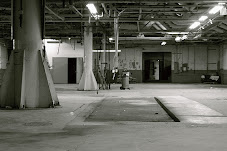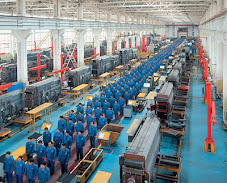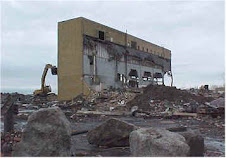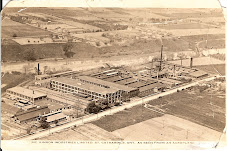Is the job market in the Canada improving or getting worse? Do you believe the low unemployment rate is accurate? Is it easy to find a good paying job in Canada?
What does the future hold for our children? How is the current US Canadian dollar rate impacting our economy? What is causing all the unrest and concern about The Crisis in Manufacturing and should we be concerned?
Most importantly, What can be Done?
Welcome To My Blog ...
This blog is being designed to help you the average working Canadian to understand some of the terminology that is being thrown around by economists and politicians. Globalization, global overcapacity, deindustrializim and brownfields, all impact the Canadian Manufacturing Industry and the Canadian Economy.
However average everyday working people like you and I, need to know what these terms mean, why these phenomenons are occurring and how they affect average citizens, their jobs, their families and our future. On the right hand side of the page you will find several useful links. Related newspaper articles, video links and links to websites that I found interesting and informative.
I hope and trust you will find this blog informative and useful, please leave your comments under the postings at the bottom of the blog.
However average everyday working people like you and I, need to know what these terms mean, why these phenomenons are occurring and how they affect average citizens, their jobs, their families and our future. On the right hand side of the page you will find several useful links. Related newspaper articles, video links and links to websites that I found interesting and informative.
I hope and trust you will find this blog informative and useful, please leave your comments under the postings at the bottom of the blog.
What is Deindustrialization?

closes plants, workers lose jobs, what created this problem?
Deindustrialization is a process of social and economic change caused by the removal or reduction of industrial activity in a country or region, especially heavy industry or manufacturing industry. Cairncross (1982) and Lever (1991) offer four possible definitions of deindustrialisation:
1. Deindustrialization can mean a straightforward decline in the output of manufactured goods or in employment in the manufacturing sector. This, however, can be misleading because short-run or cyclical downturns may be misinterpreted as long-run deindustrialisation.
2. Deindustrialization can mean a shift from manufacturing to the service sectors, so that manufacturing has a lower share of total output or employment. This may also be misleading, however, as such a shift may occur even if manufacturing is growing in absolute terms.
3. Deindustrialization can mean that manufactured goods comprise a declining share of external trade, so that there is a progressive failure to achieve a sufficient surplus of exports over imports to maintain an economy in external balance.
4. Deindustrialization can be defined as a continuing state of balance-of-trade deficit (as described in the third definition above) that accumulates to the extent that a country or region is unable to pay for necessary imports to sustain further production of goods, thus initiating a further downward spiral of economic decline.
Why should you be concerned? hundreds of thousand of good paying jobs are being lost in Canada because of deindustrialisim. These job losses are having a devastating affect for working families.
1. Deindustrialization can mean a straightforward decline in the output of manufactured goods or in employment in the manufacturing sector. This, however, can be misleading because short-run or cyclical downturns may be misinterpreted as long-run deindustrialisation.
2. Deindustrialization can mean a shift from manufacturing to the service sectors, so that manufacturing has a lower share of total output or employment. This may also be misleading, however, as such a shift may occur even if manufacturing is growing in absolute terms.
3. Deindustrialization can mean that manufactured goods comprise a declining share of external trade, so that there is a progressive failure to achieve a sufficient surplus of exports over imports to maintain an economy in external balance.
4. Deindustrialization can be defined as a continuing state of balance-of-trade deficit (as described in the third definition above) that accumulates to the extent that a country or region is unable to pay for necessary imports to sustain further production of goods, thus initiating a further downward spiral of economic decline.
Why should you be concerned? hundreds of thousand of good paying jobs are being lost in Canada because of deindustrialisim. These job losses are having a devastating affect for working families.
What is Global Overcapacity?

New manaufacturing facility in China
Overcapacity occurs when total production capability outstrips demand.This may be a temporary situation caused by normal market cycles, or a brief economic downturn. The reasons may also be structural, such as the decline of a market.
Overcapacity can also be due to increased use of technology and increased speed of production. From time to time the capacity and market changes and adjusts, these things happen.
On the other hand Global Overcapacity is often the result of a conscious decision to build more manufacturing facilities than is actually required to meet global demand.
These new manufacturing facilities are often in a different country that originally made the products and are to meet the demand of markets in other countries.
Ironically Corporation use profits made in one country to develop new manufacturing facilities in others.
This Global Overcapacity creates global competition and increases corporate profits. Any country that wants to prosper needs to have a balanced economy, which would include the ability to make and manufacture good for it own and others needs.
A long term impact of Global Overcapacity is the loss of a countries ability to make products resulting in an increased dependence on the global market.
Global Overcapacity often has a devastating impact in the Country that traditionally manufactured the products, resulting in lay offs and plant closures. Dependence on the global market will have major negative impact on all market based economies
Overcapacity can also be due to increased use of technology and increased speed of production. From time to time the capacity and market changes and adjusts, these things happen.
On the other hand Global Overcapacity is often the result of a conscious decision to build more manufacturing facilities than is actually required to meet global demand.
These new manufacturing facilities are often in a different country that originally made the products and are to meet the demand of markets in other countries.
Ironically Corporation use profits made in one country to develop new manufacturing facilities in others.
This Global Overcapacity creates global competition and increases corporate profits. Any country that wants to prosper needs to have a balanced economy, which would include the ability to make and manufacture good for it own and others needs.
A long term impact of Global Overcapacity is the loss of a countries ability to make products resulting in an increased dependence on the global market.
Global Overcapacity often has a devastating impact in the Country that traditionally manufactured the products, resulting in lay offs and plant closures. Dependence on the global market will have major negative impact on all market based economies
What are Brownfields?

How many people worked here?
The Environmental Protection Agency (EPA) defines Brownfields as “abandoned, idle or under-used industrial and commercial facilities where expansion or redevelopment is complicated by real or perceived environmental contamination.” Usually Brownfields are sites of old factories or other businesses. Many times Brownfields are unsightly and strewn with illegally dumped garbage.
Brownfields can have all kinds of dangers—debris, dilapidated buildings and even dangerous, toxic chemicals. Some dangers are easy to see—broken windows and glass, rotted wood floors, rusty nails and pipes, and old barrels. Other dangers are not visible and harder to detect—toxic chemicals that can be harmful to people if they eat them, breathe them or get them on their skin.
To me brownfields represent a medal of honour... a reminder of a prosperous past and a warning of things to come. Obviously existing brownfields need to be cleaned up and it is the responsibility of the company that made the mess to clean it up.
However, the real issue is we need to stop the trend of abandoning old manufacturing facilities, they need to be maintained, updated, be environmentally friendly and remain open.
This will not only result in maintaining jobs of the people that work there. It will create more jobs for the clean up and renovation and secure your working future.
Brownfields can have all kinds of dangers—debris, dilapidated buildings and even dangerous, toxic chemicals. Some dangers are easy to see—broken windows and glass, rotted wood floors, rusty nails and pipes, and old barrels. Other dangers are not visible and harder to detect—toxic chemicals that can be harmful to people if they eat them, breathe them or get them on their skin.
To me brownfields represent a medal of honour... a reminder of a prosperous past and a warning of things to come. Obviously existing brownfields need to be cleaned up and it is the responsibility of the company that made the mess to clean it up.
However, the real issue is we need to stop the trend of abandoning old manufacturing facilities, they need to be maintained, updated, be environmentally friendly and remain open.
This will not only result in maintaining jobs of the people that work there. It will create more jobs for the clean up and renovation and secure your working future.
Why invest in industry?

St Catharines Glendale Plant

Investment dollars at work
Should tax payers dollars be used to invest and subsidize the Canadian Economy?
Personally I cant think of a better use for the taxpayers dollar.
Personally I cant think of a better use for the taxpayers dollar.
Saturday, September 22, 2007
Subscribe to:
Posts (Atom)



